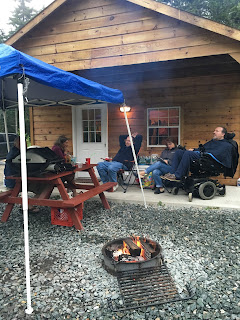Welcome to my annual post where I take a moment to consider what I’ve gained and lost in the past year, and what changes may await me in the coming one. As you know, I try to strike a balance. I don’t sugarcoat my condition, but neither do I focus only on the negative. And I reserve the right to inject humor no matter how serious the topic.
So, how did 2016 treat me? Could’ve been better. Could’ve been worse.
2016 Negatives:
- Again this year, the negatives column is all about increased difficulty getting food and drink into my mouth, due to arm and hand weakness. If a year ago I needed assistance with 10% of my bites and sips, now it's 50%.
- After a sixteen-month personal trial with no benefits observed, I gave up on an experimental MS treatment—Biotin.
- Having some difficulty operating computer mouse and wheelchair controls.
- Physical therapy continued to help me maintain the strength and flexibility in my arms and shoulders.
- I made great progress on my book throughout the year. One of these days I'm going to have to call it finished.
- I voice-automated my home.
- Just a couple of days ago, I took delivery of a new, modern, power wheelchair. More on that in upcoming posts.
- DEKA, the iBot people, put my picture on the front page of their website.
- Down East Magazine printed an excerpt from my memoir.
- Bangor Metro Magazine published a nice interview.
- The Journal Nature mentioned me prominently in an article.
- My daughter got married, and the wedding was beautiful.
- Kim's home business took off.
- Another year above ground – still preferable to the alternative.
2017 Potential Losses (if my disease progression continues, this is what could happen next):
- More eating and personal grooming struggles.
- More difficulty operating computer mouse and wheelchair controls
- Eventually my bladder is going to stop working, and that will suck. This could be the year, but I’ve been saying that for a few years now.
- Something I can’t even imagine (the devil I don’t know).
2017 Potential Gains:
- More writing success at the blog and elsewhere.
- Find a publisher for my book or decide to self-publish.
- Caribbean cruise in February, thanks to Kim's home business.
- New primary progressive MS drug called Ocrelizumab should be approved in 2017, and I will likely try it, although it's another longshot for me.
- A few positives I can’t even imagine.
I conduct this thorough review only once each year for a couple of reasons. First, it takes that long for me to determine if certain changes are the result of permanent disease progression or are merely the normal ups and downs from aging, seasonal affective disorder, or my body’s sympathetic response to the menstrual cycles of the various women in my life (apologies to my dedicated readers for recycling that joke from last year, but I couldn't resist).
Second, I only do this once a year because it can be a harrowing process. As I contemplate my losses and gains, I tend to extrapolate – envision what my life will be like down the road if the disease progression continues at this rate. I am concerned for my future health and fearful for my future happiness. But, at this moment, Enjoying the Ride is more than just a clever blog name. It’s the truth.
Second, I only do this once a year because it can be a harrowing process. As I contemplate my losses and gains, I tend to extrapolate – envision what my life will be like down the road if the disease progression continues at this rate. I am concerned for my future health and fearful for my future happiness. But, at this moment, Enjoying the Ride is more than just a clever blog name. It’s the truth.




























































